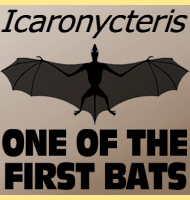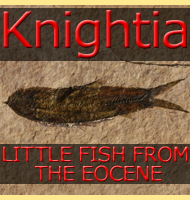


Onychonycteris
Name:
Onychonycteris
(Clawed bat).
Phonetic: Oh-nik-o-nik-teh-riss
Named By: Nancy B. Simmons, Kevin L. Seymour,
Jorg Habersetzer & Gregg F. Gunnell - 2008.
Classification: Chordata, Mammalia, Chiroptera,
Onychonycteridae, Onychonycteris.
Species: O. finneyi (type).
Diet: Insectivore.
Size: Roughly 25 centimetres long, 52
centimetre wingspan.
Known locations: USA, Wyoming - Green River
Formation.
Time period: Ypresian of the Eocene.
Fossil representation: Almost complete skull and
skeleton preserved flat on a slab.
Onychonycteris existed during the Eocene, and is regarded as one of the most primitive bats known. So primitive is Onychonycteris that the fingers all still have large claws on their ends, and study of the skull and ear bones strongly suggests that Onychonycteris was incapable of using echolocation to find prey. This is a clear indication that echolocation was developed in bats after they had already taken to the air.
Further reading
- Primitive Early Eocene bat from Wyoming and the evolution of flight
and echolocation. - Nature 451 (7180): 818–21. -
Nancy B. Simmons, Kevin L. Seymour, Jorg Habersetzer
&
Gregg F. Gunnell - 2008.
- A bony connection signals laryngeal echolocation in bats. - Nature.
Nature Publishing Group. 463 (7283): 939–942. - Nina Veselka, David D.
McErlain, David W. Holdsworth, Judith L. Eger, Rethy K. Chhem, Matthew
J. Mason, Kirsty L. Brain, Paul A. Faure & M. Brock Fenton -
2010.
----------------------------------------------------------------------------
Random favourites
 |
 |
 |




